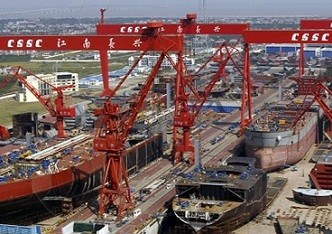Chinese firms are expected to upgrade their technology to be able to compete in the global market as free trade agreements (FTAs) with South Korea and Australia have taken effect last month, China Daily reported.
According to the report, the FTAs would encourage local manufacturers to improve their technology and help China get back to the previous level of export growth. However, the time is critical since many economies have also taken up measures to compete with China by raising their export volume through new technologies, modernizing the services sector, implementing effective marketing strategies and making investments in Southeast Asia.
Shin Un-cheol, chairman of the South Korea-China Marketing Association, said that although the price advantage is a core element in bilateral trade, it does not automatically mean cheaper Chinese products.
"On the contrary, China's packaged food industry will face challenges," Shin said. "South Korean pickled vegetables and senate chicken soup may gain because of the FTA."
Under the China-South Korea FTA, import tariffs on 91 percent of South Korean products will be removed by China over the next 20 years, while 92 percent of Chinese goods will have no tariffs as granted by Seoul.
Because of the FTA, China-South Korea annual trade volume is expected to reach $300 billion by the end of this year, according to South Korea's Ministry of Strategy and Finance.
On the other hand, under the China-Australia FTA, Chinese import tariffs on 95 percent of Australian exports have been lifted, while Chinese businesses can invest more as Australia will remove all obstacles, including relaxed visas for Chinese visitors.
Shin said China will face serious challenges as South Korea's businesses related to travel, medical services, post-retirement life, films, television and entertainment are stronger.
"If these industries in China don't raise their level of service and quality, consumers will feel they are losing out," said Shin. "Already, the China-South Korea FTA has attracted the attention of Chinese film and television people. Investment of Chinese enterprises in South Korea will see explosive growth."
This means Chinese manufacturers can no longer rely on low-cost material and cheap labor advantage to compete with foreign rivals, Dereck Ji, senior partner of Roland Berger Strategy Consultants, said.
"An open market doesn't mean lower price and low value-added products, but brands, technologies and strategic market approaches for Chinese companies. They need to put their business growth on a firmer footing," said Ji.
The FTAs will also drive large Chinese companies to upgrade their operations and eventually benefit small and medium-sized companies, Ji said.
Experts have said that the country's fast-developing 4G telecom networks and the "Made in China 2025" plan will help improve productivity and resource efficiency, which can be extended to include suppliers, manufacturers, customers and global markets.
The report said that between 2010 and 2050, China's workforce could shrink from 72 percent to 61 percent. So, inter-connected industrial operations will require a different kind of workforce and skill-sets in manufacturing. Demand for engineering and IT skills will likely increase, according to an Oct. 2015 research paper of the Beijing-based Institute of Industrial Economics, which operates under the aegis of the Chinese Academy of Social Sciences.
Zhi Luxun, deputy director-general of the department of foreign trade at the Ministry of Commerce, said that market competition may push South Korean and Australian companies in China to find new opportunities in other sectors such as services and agriculture.
"These shifts will lead to new business models, which will partly substitute old ones. In this context, the two FTAs will bring about a profound transformation in the country, and present a major challenge," said Zhi. "Higher productivity will allow higher wages and may help alleviate labor shortages."
According to the report, large-scale Chinese manufacturers such as Yantai-based CIMC Raffles Offshore Ltd. have already begun exporting more offshore oil rigs and engineering vessels to compete with South Korean shipbuilders. The company has completed development of a $550-million deepwater semi-submersible drilling rig at its Yantai production base in Shandong Province last month.
The report said that the rig was built for North Sea Rigs Holding AS of Norway, one of the largest offshore oil producers in Europe, the first China-made semi-submersible drilling rig capable of operating in the Arctic area with temperatures as low as minus 20 degrees Celsius.
The platform can operate in seawater depths of up to 1,200 meters and drill to a depth of 8,000 meters as well as withstand sea storms in the North Sea and Barents Sea, the report added.
Yu Ya, president of CIMC Raffles, said that Chinese companies must diversify to broaden their manufacturing expertise and ensure their global market share is not taken by South Korean companies.
"Major Chinese shipyards and heavy industry manufacturers today are keen to acquire European and U.S. maritime design and research firms in different sizes, because this is a big part of their tactics for gaining high-end technologies to produce core components and compete with rivals in both home and overseas markets," said Yu.
Between January and November in 2015, shipyards in China have received orders for new vessels with a collective capacity of 23.58 dead weight tons, accounting for 28.7 percent of the global market share. On the other hand, South Korea's shipbuilding industry held 38.8 percent of the global market share during the same period, the report said.



























